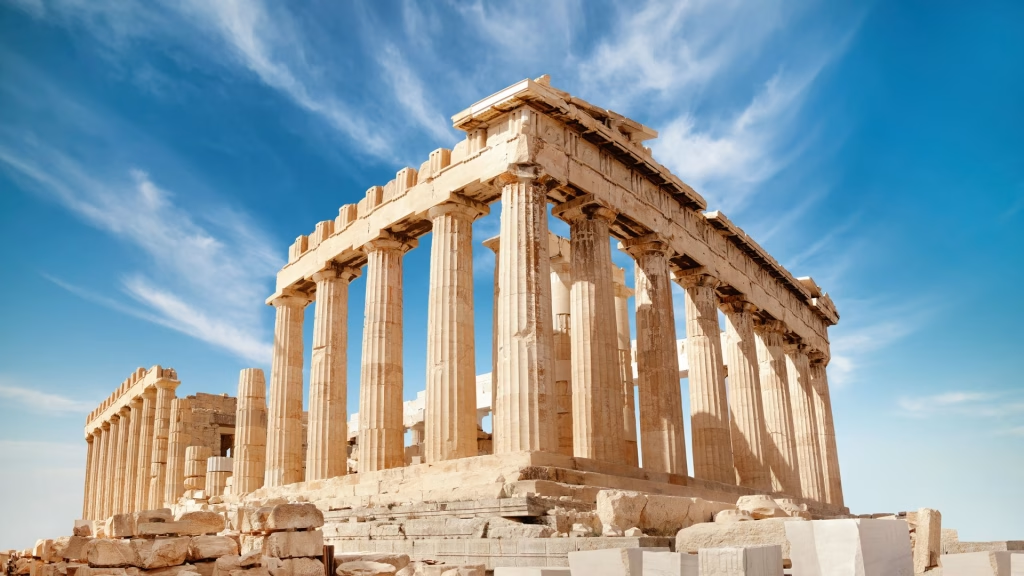When we walk through ancient ruins today, it’s easy to assume that the crumbling stones and weathered statues are precisely what these places were meant to be — gray, broken, and silent. But the truth is far more fascinating. Most of the archaeological sites we admire today were once vibrant, colorful, and alive with people, music, and activity. Columns were painted, statues gleamed, and temples buzzed with rituals and noise.
In this blog, we’ll journey back in time to explore what famous archaeological sites used to look like before centuries of decay, destruction, and erosion turned them into the ruins we know today.
1. The Parthenon – Athens, Greece
Now, A white, skeletal structure on the Acropolis, the Parthenon, looks elegant in its minimalism.
Then, in its prime, the Parthenon was bursting with color. The temple dedicated to Athena featured bright red, blue, and gold paint, especially on the pediments and friezes. Inside stood a massive gold and ivory statue of Athena, over 30 feet tall, surrounded by rich decorations, shields, and intricate carvings.
The Parthenon wasn’t just a temple — it was a monument to Athenian power, designed to impress citizens and visitors alike.
2. The Great Pyramid of Giza – Egypt
Now: A dusty, beige triangle rising from the desert.
Initially, the Great Pyramid was covered in polished white Tura limestone, which reflected the sun and made it shine like a beacon across the Egyptian desert. At its peak, the pyramid was capped with electrum (a gold-silver alloy), giving it a golden tip that could have gleamed for miles.
The smooth outer casing is gone today, but ancient visitors would have seen one of the most brilliantly shining monuments in history.
3. The Colosseum – Rome, Italy
Now: A weathered oval of stone, partially collapsed and marked by time.
Then, in ancient Rome, the Colosseum was covered in travertine marble and likely painted in certain areas. The arena itself had a massive, retractable awning system called the velarium, which shielded 50,000 spectators from the sun.
Statues stood in its niches, banners waved in the breeze, and the sounds of roaring crowds, animals, and clashing weapons filled the air during gladiatorial games. It was Rome’s ultimate entertainment venue — bustling and booming.
4. Machu Picchu – Peru
Now: A mystical, green-topped mountaintop city of stone walls and terraces.
Then, Machu Picchu was more than just a peaceful retreat. It was a royal estate, featuring brightly painted temples, gold ornaments, and buildings roofed with thatch or wooden shingles. The terraces were lush with crops, and water ran through a system of fountains and canals that sparkled in the sun.
In its heyday, Machu Picchu was a thriving mountain hub, characterized by spiritual rituals, agriculture, and Inca engineering.
5. Stonehenge – England
Now: A circle of massive gray stones surrounded by green fields.
Then, Stonehenge likely began as a vibrant ceremonial complex, used for astronomy, burial, and spiritual rites. The stones were initially smooth and may have been painted with pigments or decorated with carvings.
Surrounding structures, likely made of wood and thatch, likely existed alongside the stone formation. Some researchers suggest it was part of a much larger network of Neolithic religious sites, not just a lonely ring of rocks.
6. Chichen Itza – Mexico
Now: A well-preserved Maya ruin, dominated by the El Castillo pyramid.
Then, the city of Chichen Itza was an architectural marvel, with brightly painted temples, red and blue facades, and highly decorated stone reliefs. El Castillo itself likely featured painted serpent motifs, and its grand staircases would have been bustling during ceremonies.
At the Sacred Cenote, people gathered for religious offerings, while the Great Ball Court echoed with the sounds of ritual games. Chichen Itza was a powerful spiritual and trade center, alive with culture and color.
7. Petra – Jordan
Now: A pink sandstone city carved into cliffs, often seen in images of The Treasury.
Then, Petra was once a thriving desert metropolis — full of markets, gardens, fountains, and vibrant colors. The famous rock-cut facades were likely plastered and painted with pigments in red, yellow, blue, and white.
During the Nabataean peak, Petra was a center of wealth and culture, enriched by caravan trade routes. It wasn’t just a silent rock city; it was alive with merchants, music, and life.
8. Angkor Wat – Cambodia
Now: A hauntingly beautiful stone temple complex surrounded by jungle.
Then, Angkor Wat was once the center of the Khmer Empire, teeming with life and artistry. The temple was originally plastered and painted in bright golds and reds. Its walls were alive with colorful murals and religious scenes. The surrounding city supported hundreds of thousands of residents, with canals, reservoirs, and roads buzzing with activity.
Today’s quiet temples were once the heart of a mighty kingdom, bustling and vibrant.
9. Easter Island (Rapa Nui) – Chile
Now: Dozens of massive stone heads (moai) stare silently over windswept plains.
Then: The moai were not just heads — most have full torsos, buried by time. Many of them were painted in white and red pigments, and some even had hats (pukao) and coral eyes inlaid with obsidian pupils.
These statues likely stood in rows on ceremonial platforms, overlooking thriving villages, religious sites, and cultivated fields.
10. Pompeii – Italy
Now: A frozen ruin, preserved in volcanic ash, often gray and ghostly.
Before Mount Vesuvius erupted in 79 AD, Pompeii was a vibrant Roman town, featuring colorful frescoes, mosaic floors, public baths, theaters, bakeries, and even graffiti. Houses were brightly painted, temples adorned with statues, and the streets echoed with the sounds of carts, laughter, and daily life.
Thanks to the volcanic ash, we know more about what Pompeii looked like than many ancient cities — and it was anything but dull.
Final Thoughts: From Ruins to Reality
Many people picture ancient ruins as lifeless, colorless, and old — but that’s far from the truth. Most archaeological sites were once vivid, noisy, and bustling with energy. Statues were painted, buildings were ornamented, and every stone had a purpose.
Modern reconstructions, digital models, and archaeological discoveries are helping us gain a better understanding of what these places truly looked like. And as we peel back the layers of time, we begin to appreciate not just the remains, but the living worlds they once were.



